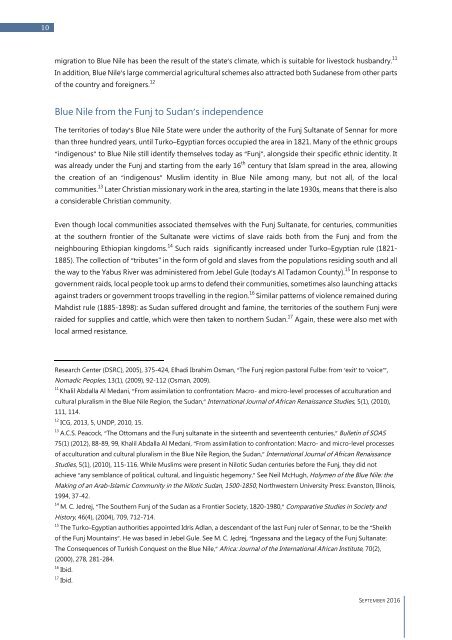A Crisis Normalised
2ctogG9
2ctogG9
Create successful ePaper yourself
Turn your PDF publications into a flip-book with our unique Google optimized e-Paper software.
10 <br />
<br />
migration to Blue Nile has been the result of the state’s climate, which is suitable for livestock husbandry. 11<br />
In addition, Blue Nile’s large commercial agricultural schemes also attracted both Sudanese from other parts<br />
of the country and foreigners. 12<br />
Blue Nile from the Funj to Sudan’s independence<br />
The territories of today’s Blue Nile State were under the authority of the Funj Sultanate of Sennar for more<br />
than three hundred years, until Turko–Egyptian forces occupied the area in 1821. Many of the ethnic groups<br />
“indigenous” to Blue Nile still identify themselves today as “Funj”, alongside their specific ethnic identity. It<br />
was already under the Funj and starting from the early 16 th century that Islam spread in the area, allowing<br />
the creation of an “indigenous” Muslim identity in Blue Nile among many, but not all, of the local<br />
communities. 13 Later Christian missionary work in the area, starting in the late 1930s, means that there is also<br />
a considerable Christian community.<br />
Even though local communities associated themselves with the Funj Sultanate, for centuries, communities<br />
at the southern frontier of the Sultanate were victims of slave raids both from the Funj and from the<br />
neighbouring Ethiopian kingdoms. 14 Such raids significantly increased under Turko–Egyptian rule (1821-<br />
1885). The collection of “tributes" in the form of gold and slaves from the populations residing south and all<br />
the way to the Yabus River was administered from Jebel Gule (today’s Al Tadamon County). 15 In response to<br />
government raids, local people took up arms to defend their communities, sometimes also launching attacks<br />
against traders or government troops travelling in the region. 16 Similar patterns of violence remained during<br />
Mahdist rule (1885-1898): as Sudan suffered drought and famine, the territories of the southern Funj were<br />
raided for supplies and cattle, which were then taken to northern Sudan. 17 Again, these were also met with<br />
local armed resistance.<br />
Research Center (DSRC), 2005), 375-424, Elhadi Ibrahim Osman, “The Funj region pastoral Fulbe: from ‘exit’ to ‘voice’”,<br />
Nomadic Peoples, 13(1), (2009), 92-112 (Osman, 2009).<br />
11<br />
Khalil Abdalla Al Medani, “From assimilation to confrontation: Macro- and micro-level processes of acculturation and<br />
cultural pluralism in the Blue Nile Region, the Sudan,” International Journal of African Renaissance Studies, 5(1), (2010),<br />
111, 114.<br />
12<br />
ICG, 2013, 5, UNDP, 2010, 15.<br />
13<br />
A.C.S. Peacock, “The Ottomans and the Funj sultanate in the sixteenth and seventeenth centuries,” Bulletin of SOAS<br />
75(1) (2012), 88-89, 99, Khalil Abdalla Al Medani, “From assimilation to confrontation: Macro- and micro-level processes<br />
of acculturation and cultural pluralism in the Blue Nile Region, the Sudan,” International Journal of African Renaissance<br />
Studies, 5(1), (2010), 115-116. While Muslims were present in Nilotic Sudan centuries before the Funj, they did not<br />
achieve “any semblance of political, cultural, and linguistic hegemony.” See Neil McHugh, Holymen of the Blue Nile: the<br />
Making of an Arab-Islamic Community in the Nilotic Sudan, 1500-1850, Northwestern University Press: Evanston, Illinois,<br />
1994, 37-42.<br />
14<br />
M. C. Jedrej, “The Southern Funj of the Sudan as a Frontier Society, 1820-1980,” Comparative Studies in Society and<br />
History, 46(4), (2004), 709, 712-714.<br />
15<br />
The Turko–Egyptian authorities appointed Idris Adlan, a descendant of the last Funj ruler of Sennar, to be the “Sheikh<br />
of the Funj Mountains”. He was based in Jebel Gule. See M. C. Jȩdrej, “Ingessana and the Legacy of the Funj Sultanate:<br />
The Consequences of Turkish Conquest on the Blue Nile,” Africa: Journal of the International African Institute, 70(2),<br />
(2000), 278, 281-284.<br />
16<br />
Ibid.<br />
17<br />
Ibid.<br />
SEPTEMBER 2016


